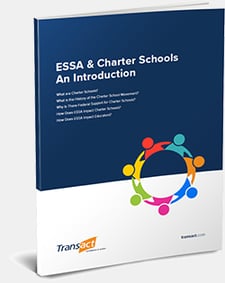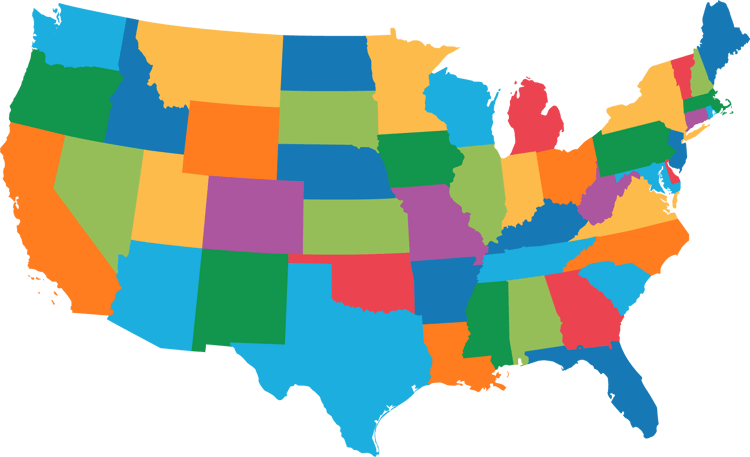
Expecting a PDF?
We created this eBook as a web page for better mobile optimization, accessibility, & maintenance. Remember, you can bookmark this page for future reading, save it to the reading list on your mobile device, or print a hard copy. If you'd still like a PDF version of this eBook, you can download it here:
Table of Contents
Introduction
Charter schools have grown steadily in the past 20 years, and the recent passing of the Every Student Succeeds Act (ESSA) provides an opportunity for increased growth and expansion. In largely bipartisan efforts, ESSA brought increased funding, support, and opportunity to the charter movement1.
THIS MEANS THAT:
While managing growth and developing innovative methods to support students growth and achievement, charter schools will also have to meet the complex and often expensive challenges of compliance with federal requirements, which can be complex and expensive in some cases.
This eBook is a guide for educators and community members who want an introduction to the charter school movement, and resources for learning more about ESSA requirements.

What Are Charter Schools?
Charter schools are non-religious, tuition-free public schools that are open to all students. They operate and are held accountable under a chartering contract. Charter schools can be independent single-school sites or part of a larger network of charter schools operated by a management organization and governed by a board. Some charter schools are a part of a local school district (district-charters) while other charter schools may be treated as a separate school district. The key difference between charter and traditional public schools is they are granted flexibility and autonomy from some state and local rules. However, in exchange for this flexibility, charter schools are held highly accountable for their success each year by their governing boards, which have the authority to renew or revoke operations of the charter school every few years.
WHAT IS THE HISTORY OF THE CHARTER SCHOOL MOVEMENT?
1974

Ray Budde, an educator and administrator at the University of Massachusetts, presents the concept of charter schools to the Society for General Systems Research. In his “Education by Charter” presentation to the Society, Budde proposed a concept for a new kind of public school that would allow educators to experiment with innovative ways of engaging and educating students.
1988
Al Shanker, President of the American Federation of Teachers, champions reform in a speech by calling on educators to increase the speed of reform across the country, and provide a mechanism for self-governed schools who innovate to meet the needs of more learners.
1991
The State of Minnesota passes the first charter school law in the nation and carves a pathway for the establishment of City Academy Charter School, the first charter school.
1996
Charter Schools have expanded rapidly and meet a milestone of 800 schools across 25 states within five years.
2017 - TODAY
Nearly 7,000 charter schools present2 in 44 states and the District of Columbia3. 3.1 million students enrolled, 7% of the total number of students enrolled in all public schools4.
Number of Charter Schools and Charter School States
| Beginning of School Year | Number of States with Charter School Laws | Number of States with Charter Schools | Number of Charter Schools | Source |
| 1992 - 1993 | 2 | 1 | 2 | Nelson et al. ( 2000 ). ( Note: Data include Washington, DC., starting in 1996 - 1997. but not Puerto Rico, which authorized charter schools in 1993. ) |
| 1994 - 1994 | 8 | 3 | 36 | |
| 1994 - 1995 | 11 | 6 | 100 | |
| 1995 - 1996 | 18 | 10 | 254 | |
| 1996 - 1997 | 26 | 17 | 432 | |
| 1997 - 1998 | 30 | 24 | 721 | |
| 1998 - 1999 | 34 | 28 | 1,122 | |
| 1999 - 2000 | 34 | 28 | 1,122 | SRI ( includes D.C. and Puerto Rico ) |
U.S. Department of Education, Office of the Under Secretary, Planning and Evaluation Service. Elementary and Secondary Education Division. (2000). Evaluation of the Public Charter Schools Program: Year One Evaluation Report, Washington, D.C., 20202.
Why is There Federal Support for Charter Schools?
The charter school movement has created some concerns throughout the education community. However, some research over the course of the last decade indicates that charter schools are making a positive impact on student growth and achievement, and that certain communities across the nation are searching for an increase in school choice.
Specifically, the 2013 National Charter School Study5 published by the Center for Research on Education Outcomes (CREDO) at Stanford University is frequently referenced for charter school effectiveness. The study showed:
- An increase in charter school enrollment among students who live at or below poverty level, English Learner (EL) students, and Black and Hispanic students
- In the aggregate, charter schools have a positive impact on these students amounting to:
Additionally in 2014, the How Parents Perceive School Choice Research Project6 from The Center for Education Policy Research (CRPE) at Harvard University looked at 4,000 parents in eight urban cities across the country and based on survey and interview responses, determined that parents are taking advantage of school choice opportunities, and desire more high quality school choice options for their children.

Are Charter Schools Held Accountable to the Same ESSA Requirements as Traditional Schools?
The Every Student Succeeds Act (ESSA) provides funding for charter schools, and introduces compliance requirements that charter schools will have to address. Charter schools are public schools funded by taxpayer dollars and so they are held accountable to abiding by the laws and regulations of the American Education System, even though state charter school laws can create environments where charter schools operate much differently compared to traditional schools. As part of the American Education System, charter schools must follow federal education policies and laws such as the ones listed below.The Elementary SecondaryEducation Act (ESEA) of 1964 and its subsequent reauthorizations:
- Improving America’s Schools Act
( IASA 1994 ) - No Child Left Behind Act
( NCLB - 2001 ) - Every Student Succeeds Act
( ESSA - 2015 )
Section 504 of the Rehabilitations Act (1974)
Individuals with Disabilities Education Act (IDEA 2004)
The Civil Rights Act (1964)
Under federal laws like ESSA, charter schools are held to the same accountability requirements as traditional schools. Some examples of such accountability are:
- School performance as outlined in the
state determined systems in each state’s
ESSA State Plan - Required annual academic and English
proficiency assessments - Parent and Family Engagement policies
and activities for ESSA funded charters - Provision of a Free and Appropriate
Public ducation (FAPE) for students
with disabilities
TransACT® Parent Notices is an online subscription to legally reviewed parent notifications translated into priority languages, that charter schools use to manage requirements for ESSA, English Learners, Section 504, IDEA, and more.
DECEMBER 2015
Congress reauthorized ESEA as Every Student Succeeds Act (ESSA), replacing No Child Left Behind (NCLB) to reflect federal education policies that support and enhance the success of education agencies across the nation. ESSA grants more autonomy to states and districts and provides support for expanding and strengthening the quality of charter schools. “The Every Student Succeeds Act isn’t just a reaction to negative feedback about No Child Left Behind. It’s also a bipartisan recognition that some facets of federal education policy – such as support for charter public schools have been a resounding success” Nina Rees, CEO and President of the National Alliance for Public Charter Schools.
The most prominent policy changes that speak directly to charter schools can be found in Title IV Part C, known as the Expanding Opportunity Through Quality Charter School Program (CSP) grant. CSP was included in NCLB, but under ESSA, CSP could potentially help increase support and funding for replication and expansion of high quality charter schools, as well as provide technical and financial support to secure and obtain school facilities.


TYPES OF FUNDING
Charter schools in every state are funded based on student enrollment, and receive funding from the state and the district.
The per pupil amount that charters receive varies by state, and is based on each state’s funding formula.
Research indicates that charter schools receive less per-pupil funding than traditional public schools in most states.
David Arsen and Yong Mei Ni, “Is Administration Leaner in Charter Schools? Resource Allocation in Charter and Traditional Public Schools.”
IN ADDITION TO PER-PUPIL FUNDING, SOME OTHER SOURCES OF FUNDING THAT CHARTER SCHOOLS CAN ACCESS ARE:
- ESSA CSP (Charter School Programs Grant) - CSPs support specific functions, and come with requirements
- Categorical Aid - federal and state education financial support to help districts and charters serve a different categories of students, special programs, or special projects
- Independently raise funds through foundation, private donors and other grants
Prior to ESSA, in Fiscal Year 2016 (FY2016), funding for charter schools reached $333 million after a 33% increase ($80 million) of funding over the previous year. ESSA provides for lower funding levels at only $270 million authorized for FY2017 and FY2018 which will increase to $300 million for FY2019 and FY2020. Congress has the authority to allocate more funding than is authorized, but the actual funding levels for these upcoming fiscal years has yet to be determined.
FUNDING FROM ESSA BRINGS AN INCREASE IN EXPECTATIONS AND THE OPPORTUNITY TO SUPPORT HIGH-QUALITY CHARTER SCHOOLS. THE THREE MAJOR CHARTER SCHOOL THEMES AROUND SCHOOL SUPPORT, IMPROVEMENT, AND EXPANSION INCLUDE:
- Strengthening the charter school authorizing process in order to improve performance management, include oversight and monitoring, evaluation of schools, and include transparency
- Improving quality, accountability, and operational performance of authorizing entities such as Charter Management Organizations (CMOs), states, and districts
- Increasing the types of eligible authorizers
To read more about the description of the CSP grant funding opportunity click here8
- Strong charter laws and policies
- Support provided for new charter schools
- Strong school accountability
- Focus on closing the per-pupil funding equity gap between traditional public and charter schools
- In September 2017, the U.S. Department of Education awarded CSP grants in the amount of $253 million
STATE ENTITY GRANTEES10
| Grantee Name | FY 17 Funding (Year 1 and 2 Funding) |
Total Recommended Funding |
| Indiana Department of Education | $24,002,291 | $59,966,575 |
| Maryland Department of Education | $5,490,859 | $17,222,222 |
| Minnesota Department of Education | $22,381,611 | $45,757,406 |
| Mississippi Department of Education | $4,240,819 | $15,000,000 |
| New Mexico Public Education Department | $6,358,693 | $22,507,805 |
| Oklahoma Public school Resource Center, Inc. | $4,264,870 | $16,499,722 |
| 1998 Rhode Island Department of Education | $1,953,000 | $6,000,000 |
| Texas Education Agency | $38,034,535 | $59,164,996 |
| Wisconsin Department of Public Instruction | $37,954,114 | $95,777,775 |
| TOTAL: | $144,680,792 | $337,896,501* |
CHARTER MANAGEMENT ORGANIZATION GRANTEES10
| Grantee Name | State** | FY17 Funding | Total Recommended Funding |
| Ascend Learning, Inc. | NY | $3,661,357 | $9,484,885 |
| Brooke Charter Schools | MA | $353,747 | $836,136 |
| Eagle Academy Public Charter School | DC | $449,066 | $812,885 |
| East Harlem Tutorial Program | NY | $542,640 | $2,781,280 |
| Environmental Charter Schools | CA | $566,063 | $900,000 |
| Family Life Academy Charter Schools, Inc. | NY | $739,260 | $900,000 |
| Fortune School of Education | CA | $1,350,600 | $2,043,100 |
| Freedom Preparatory Academy, Inc. | TN | $1,451,301 | $4,297,000 |
| Great Oaks Foundation, Inc. | NY | $1,958,400 | $3,834,000 |
| Hiawatha Academies | MN | $1,121,400 | $1,875,000 |
| IDEA Public Schools | TX | $26,316,168 | $67,243,986 |
| New Paradigm for Education, Inc. | MI | $2,365,400 | $5,084,100 |
| Rocketship Education | CA | $5,090,134 | $12,582,678 |
| Success Academy Charter Schools, Inc. | NY | 3,225,240 | $6,130,200 |
| The Freedom and Democracy Schools Foundation, Inc. | MD | $603,003 | $1,533,528 |
| University Prep, Inc. | CO | $1,360,730 | $3,734,750 |
| Voices College-Bound Language Academies | CA | $1,258,415 | $2,699,999 |
| TOTAL: | $52,412,924 | $126,773,527 |
CREDIT ENHANCEMENT GRANTEES FY201710
| Grantee Name | State** | FY17 and Total Project Funding |
| Building Hope…A Charter Schools Facilities Fund | DC | $8,000,000 |
| California School Finance Authority | CA | $8,000,000 |
| Center for Community Self-Help | NC | $8,000,000 |
| Charter Schools Development Corporation | MD | $5,000,000 |
| Hope Enterprise Corporation | MS | $8,000,000 |
| Low Income Investment Fund | CA | $8,000,000 |
| Massachusetts Development Finance Agency | MA | $8,000,000 |
| Raza Development Fund | AZ | $3,250,000 |
| TOTAL: | $56,250,000 |
How Does ESSA Impact Charter Schools?
ESSA regulations went into effect on July 1st 2017, leaving charter schools and traditional schools alike scrambling to understand how their work would change as a result of new laws. Aside from the policy and funding changes, schools, teachers, principals, administrators, parents, and school employees who work directly with students are impacted by ESSA in 6 main areas listed below.
- State Standards
- School Accountability and Accountability changes from NCLB to ESSA
- Closing the achievement gap for schools identified for improvement
- Teacher certification and evaluation
- Parent and family engagement
- Supports for english learners

State Standards
Under ESSA, the U.S. Department of Education is prohibited from requiring or influencing the adoption of standards (ESSA Title I, Section 1111(b)(1)(G)(ii)). This means that:- The U.S. Department of Education must remain neutral on the adoption of standards under ESSA (Title I, Section 1111(b)(1)(G)), whereas under NCLB the U.S. Department of Education forced states to comply with federally defined conditions in order to receive ESEA Flexibility waivers and Race to The Top grants
- States now choose their standards. Depending on the state, if there is local control in the choice of curriculum, districts may have the opportunity to develop their own curriculum or make recommendations on curriculum choices that adhere to the standards chosen by their state in alignment with ESSA requirements
WHAT THIS MEANS FOR YOU:
Your state may decide to keep the current standards, or decide to adopt or create a new set of standards, potentially forcing (or enabling) districts and charters to change their curriculum. Check with your charter school or school district to see if there will be any changes in your curriculum to meet your state standard requirements under ESSA.

SCHOOL ACCOUNTABILITY AND ACCOUNTABILITY CHANGES FROM NCLB TO ESSA
Under ESSA, accountability changes shifted from more federal control to more state and local autonomy. Generally, the term “school accountability” refers to whether or not a school meets the goals set by the state for various measures of school success. Under ESSA, some school accountability changes include:
- States decide how schools should be held accountable for serving all students
- Accountability systems are described in each state’s ESSA state plan (Access your state’s education plan here11)
- ESSA sets forth parameters that states must ensure are included in accountability, while still granting the flexibility for states to define their own systems. (Title I, Section 1111(c))
- Low performing schools are identified as such based on state determined accountability measures
This caused stress and frustration for schools and school districts because of the near impossibility of having all students in all schools meet the 100% proficiency goal. Along with these onerous requirements, this policy also created a less-than desirable practice of overly focusing on teaching towards the test.
When the 10-year time frame was reached, requiring the 100% proficiency goal for all schools, the U.S. Department of Education offered waivers to NCLB accountability known as ESEA Flexibility Waivers. If a State didn’t apply for an ESEA Flexibility Waiver, then it was likely that all or nearly all schools in the state would be identified for improvement due to NCLB’s 100% proficiency requirements. Although ESEA Flexibility Waivers provided relief, they came with a significant number of conditions for approval, like the requirement for common academic standards and teacher evaluation linked to student performance.
To read more about the ESEA Flexibility Waiver, click here.12
The changes may be a result of dissatisfaction due to strong federal control under NCLB. Under NCLB, all schools were strictly required to reach a 100% academic proficiency rate on the state’s annual content test within 10 years of NCLB implementation.
Many state leaders and the U.S. Congress felt that the U.S. Department of Education had overstepped its authority in requiring these conditions. As a result, ESSA represents a shift away from a heavy federal accountability system to a state defined system (within federal parameters) and significant restrictions on what U.S. Department of Education can require. The new ESSA school accountability parameters are as follows:
States must develop their own measurements across different indicators (ESSA Title Section 1111(c)(4)(C)). These indicators are:
- Proficiency on the state’s reading and math tests
- English Learner progress toward English language proficiency
- Graduation rates for high schools
- Student growth or another academic
- indicator that is valid, reliable and can be standardized statewide (for elementary and middle schools)
- At least one other indicator of school quality or success, such as measures of safety, student engagement or educator engagement
ACCOUNTABILITY SYSTEM REQUIREMENTS INCLUDED IN THE ESSA FEDERAL FRAMEWORK ARE:
- States are required to include at least four of the five indicators in their accountability system. Most schools will be held accountable for four indicators, which may vary depending on the grade levels of the school (i.e. high schools must include graduation rates and may include a measure of growth or other academic indicator, potentially giving them five indicators)
- States will have to identify, and districts must intervene in, schools identified for improvement, including high schools with a graduation rate of 67% or less
- The 95% participation rate on state tests is still required, but there is new flexibility on how those rates are determined and what consequences schools or districts will face when they do not meet targets
WHAT THIS MEANS FOR YOU:
Schools and districts now need to focus on meeting the goals for various indicators when determining school success rather than depending solely on test scores. This includes, for the first time, a measure of school quality or success that may not be tied to academics. Review your state ESSA plans to reference the school accountability measurement indicators and ensure that your school is on target to be compliant.
CLOSING THE ACHIEVEMENT GAP FOR SCHOOLS IDENTIFIED FOR IMPROVEMENT
ESSA eliminated the NCLB Adequate Yearly Progress (AYP) requirement and now requires Annual Meaningful Differentiation (AMD), which is the new term to refer to accountability measures for identifying school performance levels in order to close achievement gaps. NCLB school improvement categories of ‘improvement’, ‘corrective action’, and ‘restructuring’, which identified schools as being progressively worse over time, have been replaced in ESSA with only two categories that are only identified once every three years.
The two categories of schools identified for improvement under ESSA are Comprehensive Support and Improvement Schools or Targeted Support and Improvement Schools. Interventions to close achievement gaps in these schools are no longer federally prescribed, but are to be determined by states and school districts.
Schools identified for Comprehensive Support and Improvement are identified based on the performance of all students in the school (the lowest performing 5% of schools). High Schools that graduate less than two thirds of their students may also be identified for Comprehensive Support and Improvement. In these schools, interventions are chosen by the school district and approved by the state.
Schools identified for Targeted Support and Improvement are identified based on the performance of specific subgroups of students (i.e. race/ethnic groups, English Learners, students with disabilities). In these schools, interventions are chosen by the school and approved by the school districts.
Schools identified for support and improvement must develop and implement support and improvement plans. ESSA provides requirements regarding the development of Comprehensive or Targeted Support and Improvement plans:
- Teachers, leaders, and parents help identify evidence-based strategies to improve student outcomes
- Locally designed improvement plans that meet the needs of students in the local context. This is not a one-size-fits-all type approach, especially in schools with one or more subgroups identified as struggling academically
- States and districts must monitor the school improvement efforts
If a school fails to sufficiently improve performance over a state prescribed number of years after implementing a Target Support and Improvement plan, the school’s improvement designation can be changed to Comprehensive Support and Improvement. ESSA provides funding for schools identified for Comprehensive or Targeted Support and Improvement. The NCLB Title I 1003(g) School Improvement Grant program has been eliminated and the funding for this program (approximately $500 million) has been merged into Title I funds. States are now required to set aside 7% of their Title I funds to support schools in improvement, up from 4% under NCLB’s 1003(a) school improvement funding set-aside. In effect, this transferred the funding from the NCLB Title I 1003(g) grants, increasing the amount of funding available for other school improvement grants (ESSA Title I, Section 1003).
WHAT THIS MEANS FOR YOU:
Schools identified for improvement will be identified for significantly different reasons, and will exit improvement in different ways. Under NCLB it took at least two years to exit school improve-ment status, but now low performing schools are identified for three year periods and reevaluated at the end of the third year. There are now two different school improvement designations, not three progressively worse designations. School improvement designations are assigned because of either the performance of all students or specific subgroups of students. And perhaps most significantly, a school may be identified as Targeted Support and Improvement based solely on the performance of the English Learner subgroup’s lack of progress toward English proficiency. Never before have school improvement determinations been made based on a measure of ELs’ progress toward English proficiency nor have school improvement funds ever been required to target this performance indicator.
To Learn More About the ESSA Accountability Chart - click here13
TEACHER CERTIFICATION AND EVALUATION
ESSA brought about some changes to the way teacher certification and teacher evaluation was addressed in NCLB and the ESEA Flexibility Waivers. Some of the changes include:
- NCLB’s highly qualified (HQ) teacher requirements are eliminated
- Teachers are required to meet state
certification and licensure requirements for the grades and subjects they teach (ESSA Title I, Section 1111(g)(2)(J)) - States and districts do not have to set up new teacher evaluation systems, but can if they so choose
WHAT THIS MEANS FOR YOU:
Educators do not have to worry about the HQ NCLB teacher mandates. In general, state certification and licensure is required for teachers, however, for charter schools this may be different depending on the state’s charter school laws. Charter school educators should check with their administrators as this is one area where the flexibility for charter schools is particularly evident.

PARENT AND FAMILY ENGAGEMENT
Parent and family engagement has received an intensified focus under ESSA (Title I, Section 1116), and the U.S. Department of Education has indicated that they will be devoting increased attention to enforcing Parent and Family Engagement under ESSA. Communication and engagement is a priority in ESSA and additional requirements have been added to school and district report cards in an effort to increase accountability and transparency with parents and the community. These requirements can create bureaucratic and logistical stress and increased costs for districts and charters, as they look to:
- Identify areas where they are required to distribute parent and family notifications
- Write the notifications in plain language style that is clear to all parents
- Legally review notifications to ensure that they are compliant with ESSA, particularly in places where charters and districts are especially vulnerable, such as Lawsuit Accuses Brooklyn Charter School of Failing to Provide Special Education Services or St. Paul schools sued on behalf of English language learners
- Protect civil rights by providing the notifications in a language parents can understand as required under ESSA
The law specifically addresses the need for schools to be responsive to parental voice, and ensure all parents are notified of Title I programs, activities, and procedures. Specifically, schools must do their due diligence in reaching all families and to the best of their abilities, ensure communications are provided to families who have limited English proficiency, those who have special needs, and families with migratory children.
These communications must be provided in a language that parents or guardians understand, regardless of the language spoken by the student.
WHAT THIS MEANS FOR YOU:
Charter schools must implement a communications strategy that complies with ESSA requirements. In general, charter schools must quickly organize resources such as federal programs administrators, a legal review team, and translators in order to adhere to ESSA parent and family engagement requirements, including:
- In carrying out Title I parent and family engagement requirements, charters must conduct outreach and provide all parents with important information and school reports required under Section 1111, and this must be provided in a language that the family can understand, and in a timely manner. If it is not practicable or possible to provide written translations, guidance from U.S. Department of Education indicates that it is always considered practicable to provide this information via oral interpretation
- District and Charter schools must implement programs, activities, and procedures that involve parents and family members in Title I programs
TransACT is a leading organization in delivering federally aligned, multi-language communication strategy management to state, charters and districts nationwide. A TransACT subscription is fundable using Title I and Title III grant money, and helps districts and charter schools stay compliant with the communication requirements of ESSA while improving parent engagement at a low per student cost.
Contact us to discuss a network-wide subscription for your charter or download our eBook on creating a compliant communication strategy.
Click here to read more about Parent Engagement Requirements under ESSA14
SUPPORTS FOR ENGLISH LEARNERS
States must have in place English Language Proficiency (ELP) standards that include all four domains of language development: reading, writing, listening, and speaking (ESSA Title I, Section 1111(b)(1)(F)). If your state’s ESSA State Plan includes the adoption of new ELP standards, your school may be required to administer a new state ELP assessment that aligns to your state’s new ELP standards. This may also mean that your EL team may need to revise the current EL curriculum to align with new ELP standards. In ESSA, your state has two options on how it decides to include ELs who have been enrolled in U.S. schools for less than one academic year in accountability determinations(Title I, Section 1111 (b) (3) (A)). The two options are:
To learn more about English Learners under ESSA, see: English Learners and ESSA for States and Charter Schools15
Conclusion: Given the current trends and the investment in charter schools from federal grants, the charter movement is likely to continue growing in the coming years. Leveraging federal charter school funding to provide more quality school options for students that need it the most is one way to promote access to high-quality education for every student. Charter school success will be impacted by how charter schools manage competing priorities of innovation and regulatory requirement in the upcoming years under ESSA.
OPTION A
States may exclude one administration of the reading/language arts assessment and may exclude ELs other test scores from accountability determinations for the first year.
OPTION B
This is a phased in approach that is only available to states that can provide a measure of growth from year to year. ELs take the tests in all years, but accountability determinations are phased in over three years:
- No accountability determinations would be made in the first year
- Only a measure of growth would be included in the second year
- Measures of both growth and proficiency would be included in the third year and beyond
Want More?
We Recommend These Resources
- A guide to collaborating for EL Success under Title I and Title III
- Quick Brief on Family Engagement in ESSA of 2015
- Rating the Ratings; An Analysis of the 51 ESSA Accountability Plans
- ESSA State Plans in Review
- National Association of Charter School Authorizers
- National Alliance for Public Charter Schools
- The TransACT Blog
TransACT® Parent Notices is an online subscription to legally reviewed parent notifications translated into priority languages, that charter schools use to manage requirements for ESSA, English Learners, Section 504, IDEA, and more. Learn more here
Common Related Terms
AUTHORIZER
Authorizers are responsible for approving charter applications, monitoring charter schools to ensure success, and ultimately for closing any schools they sponsor that fail to meet the operational and educational integrity.
CHARTER SCHOOL
A charter school is a non-religious, tuition-free public school that is open to all students. They operate and are held accountable under a chartering contract. Charter schools can be independent single school sites or part of a larger network of charter schools operated by a management organization.
CHARTER (LAW)
Mostly created at the state level, a charter law is a set of laws created that govern charter schools. The charter law will dictate parameters around the creation of charter schools within a state. The content of the charter law is very important as it plays a large role in setting the stage for the success or failure of a charter school or network that opens within the state.
GOVERNING BOARD
A nonprofit organization committed to strengthening the governance and quality of public charter schools and are held accountable by the authorizer, the state, and the federal government.
CHARTER MANAGEMENT ORGANIZATION (CMO)
Charter Management Organizations (CMOs) are nonprofit entities that manage two or more charter schools. They help with the operational functions for charters such as teacher recruitment, professional development, advocacy, data analysis, public relations and advocacy.
EDUCATION MANAGEMENT ORGANIZATION (EMO)
Education Management Organizations (EMOs) are for-profit entities that manage charter schools and perform similar functions as CMOs. EMOs generally charge a management fee for their services to charter schools.
ABOUT THE AUTHORS

Tina Nguyen, Ed. M.
Tina Nguyen started her education career as a D.C. Teaching Fellow where she taught in inner city schools and worked on education policy initiatives to advocate for science and STEM education in the reauthorization of No Child Left Behind. After graduate school, she helped lead the City of Columbus’ city-wide universal Pre-Kindergarten initiative and was a policy advisor for the Mayor-Sponsored Charter School initiative under Mayor Michael B. Coleman. She holds a B.A. in Education from California State University of Long Beach and a Masters in Education Policy and Management from the Harvard Graduate School of Education.

David Holbrook, Ph.D
Dr. David Holbrook is a nationally recognized leader in federal programs administration and monitoring with expertise in Title I, Title III, Native American Education, and Federal Programs. Dr. Holbrook has also worked as a consultant with Title III of the US Department of Education and now serves as Executive Director, Federal Compliance and State Relationships.
Book a Demo
Fill out this form today to book a demo for ParentNotices


